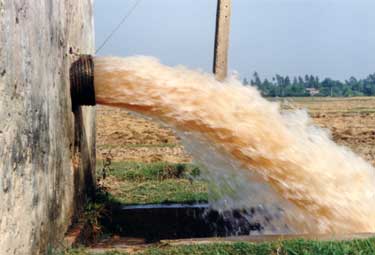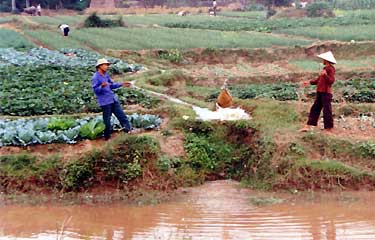Tiempo Climate Cyberlibrary
Water: Who Needs It?
- Tiempo archive
- Complete issues
- Selected articles
- Cartoons
- Climate treaty
- Latest news
- Secretariat
- National reports
- IPCC
About the Cyberlibrary
The Tiempo Climate Cyberlibrary was developed by Mick Kelly and Sarah Granich on behalf of the Stockholm Environment Institute and the International Institute for Environment and Development, with sponsorship from the Swedish International Development Cooperation Agency.
While every effort is made to ensure that information on this site, and on other sites that are referenced here, is accurate, no liability for loss or damage resulting from use of this information can be accepted.
|
The International Decade for Action, Water for Life, extends from 2005 to 2015 and is the latest campaign to focus on the issue of ensuring the provision of safe water for every person on the planet.
The overall objectives of the Water for Life Decade are:
- to infuse a sense of urgency and ensure acceleration of effort by all stakeholders in order to meet the 2015 Millennium Development Goals' water and sanitation targets;
- to promote greater awareness of the broader picture of how Integrated Water Resources Development and Management critically underpins the efforts to achieve all of the Millennium Development Goals, not only Target 10; and,
- to catalyse and scale-up the participation of civil society towards building greater societal commitment for the Water for Life effort.
These water-related goals are intrinsically set within the context of the Millennium Development Goals, the Johannesburg Plan of Implementation of the World Summit on Sustainable Development, and Agenda 21.
Access to water and the everyday use of it in drinking, cooking and cleaning our bodies, homes and workplaces is an automatic and presumed essential within the daily lives of so many of us. We give little or no thought to its availability. Water is there, as it should be. We turn on our taps and it pours forth as it surely should. It is used with an abandon that is only akin to our unthinking process of breathing in air.
Yet whilst billions of us we move through our secure worlds with its clean, healthy water, there are millions dying every year through a lack of this essential resource.
Around four thousand children alone die every day because the only water they can use is unhealthy, contaminated and unfit for human use. For every ten people in the world, two of these have no source at all of safe, clean drinking water. For every ten people in the world, four of these do not even have access to simple pit latrines, let alone the unheard of luxury of a flush toilet.
It is in recognition of the magnitude of this humanitarian crisis and the urgency for accelerated action on all social levels to provide and improve accessibility to healthy water that the United Nations has designated the next ten years the Water for Life Decade.
|
View webcast Kofi Annan, United Nations Secretary-General, at the launch of the Water for Life Decade, 22nd March 2005. |
Ensuring that each and every person has, at the very least, adequate use of clean, safe water for drinking and sanitation purposes is a matter of utmost urgency. But there are other issues associated with the provision and use of water which must also be addressed.
Water is needed for agricultural purposes. An inadequate water supply, whether it be caused through drought or the inefficient use of available water, leads to deprivation, hardship and starvation for millions. Crops become diseased or may grow stunted and lack proper nutrition or they may just die.
There are millions of people whose days are spent wholly in the pursuit of collecting water. These are, in the main, women and children. Their days are occupied with walking, sometimes great distances, to collect and haul precious water. Not only do they have a lack of safe water but their days of drudgery result in ill health, disease and shortened lives and, for the children, a lack of any education.
Then there are the numerous conflicts that occur because of inadequate or inefficiently preserved water supplies. When poor rainfalls occur, or rivers run low, or river basins and aquifers are depleted, so conflict often results as to who gets the remaining water. Conflicts occur not only within communities in particular regions, but also between nations and races as people strive to harness what is and should be a shared resource.
His Royal Highness Prince Willem-Alexander, the Prince of Orange of the Netherlands, recently observed that "the world water crisis is a crisis of governance - not one of scarcity. No single type of intervention has greater overall impact upon economic development and public health than the provision of safe drinking water and proper sanitation."
|
|
The Millennium Declaration, which was adopted in September 2000, set clear, time-bound targets to ensure progress was made on urgent development issues. Millennium Development Goal 7 includes Target 10: halve, by 2015, the proportion of people without sustainable access to safe drinking water and basic sanitation. Target 10 was highlighted at the 2002 World Summit on Sustainable Development in Johannesburg and it was then agreed that a sanitation target be added.
The World Health Organization has reviewed progress in meeting the water and sanitation targets. Progress has been made over the past few years, and political will has resulted in an improved quality of life for many millions of people, but there remains a great deal of effort needed if our global community is to fulfil its commitments.
In the words of Mikhail Gorbachev, Chairman of Green Cross International, "we must aim for universal access to water and basic sanitation - anything less is a violation of our civilization, our human rights, and our morality."
At the 13th Session of the Commission on Sustainable Development (CSD-13), held in New York 11th-22nd April 2005, governments agreed to further strengthen the commitments and targets on water as well as promoting accelerated accessibility to water resources.
The aim of CSD-13, the first policy-setting session of the Commission since the World Summit in Johannesburg in 2002, was to prioritize decisions on policies and practical measures to accelerate progress regarding water, sanitation and human settlements.
As an initial means of addressing this goal, the European Union informed participants that seven European Union countries have committed themselves to achieving the 0.7 per cent of gross national product target by 2015. This would bring the number of countries that have reached the target to twelve.
|
In the words of the Advocacy Guide for the Water for Life Decade, the theme, Water for Life, is "a call to reach out beyond the community and to link with worldwide efforts of international agencies, non-governmental organizations, governments and the community-at-large. It is an opportunity to capitalize on the energy and commitment of people, and to achieve a common goal: to bring global and local attention and to galvanize action, so that every person on the planet is less vulnerable to water stress, water-related disasters and poor water quality." |
The more than 100 government ministers at CSD-13 recommended that, to accelerate progress in providing safe drinking water, economic incentives should be instituted so as to encourage the participation of small-scale water service providers. It was also recommended that affordable water tariffs be implemented which would contribute to the financial sustainability of water services and that subsidies for the poor, to include connection costs, should be a priority target.
Other priority recommendations included:
- a call for better water management, including more efficient irrigation and wider use of rain water harvesting technologies, especially in the agricultural sector;
- implementing irrigation projects with a focus on the poor, particularly in Africa; and,
- training farmers and water user associations in efficient water use.
Recommendations, though, can only be successfully implemented if governments follow through on their commitments.
|
|
As Ambassador John Ashe of Antigua and Barbuda, Chairman of CSD-13 stated, "governments have the primary role in promoting improved access to safe drinking water, basic sanitation, sustainable and secure tenure, and adequate shelter, particularly for the poor. More and better targeted financing for the poorest countries is critical if they are to fulfill this responsibility."
More and better financing is not entirely the solution, though.
The insurmountable debts that many nations are confronted with was recognized. Finance and development ministers were asked to actively cooperate in trade negotiations and in devising aid packages, which would provide a fair means for the development of poor nations and which would facilitate the meeting of Millennium Development Goals.
"Too many countries, especially in Africa, are still being forced to choose between servicing their debts and making investments in agriculture, health, education and infrastructure," concluded Louise Frechette, United Nations Deputy Secretary-General.
According to the United Nations, the ten-year period of 2005-2015 will be critical - the time has come for intensifying advocacy efforts and action on the ground. The Water for Life Decade gives the world "a greater focus on water-related issues, while striving to ensure the participation of women in water-related development efforts, and further cooperation at all levels."
Further information
Secretariat of UN-Water, United Nations Department of
Economic and Social Affairs (UNDESA), Division for
Sustainable Development New York, 2 UN Plaza, DC2, Room
2024, NY 10017, USA. Fax: +1-212-9634340. Email: unwater@un.org. Web: www.un.org/waterforlifedecade/.
On the Web
The Water
for Life Decade website features information, data and
statistics on the global water issue and will be updated
regularly throughout the decade. Resource sheets are
available and a new sheet will be prepared with new themes
every year for each World Water Day. A
briefing document on the Water for Life Decade is
available (2 Mb download). The Advocacy Guide for the Water
for Life Decade can also be downloaded (1 Mb download) in
Chinese,
English,
French,
Russian
or Spanish.
Both documents can also be requested from the United
Nations Secretariat at the address above. The Tiempo
Climate Cyberlibrary makes available a listing of theme
sites on
water management.
Bright Ideas

General Electric plans to cut solar installation costs by half

Project 90 by 2030 supports South African school children and managers reduce their carbon footprint through its Club programme

Bath & North East Somerset Council in the United Kingdom has installed smart LED carriageway lighting that automatically adjusts to light and traffic levels

The United States National Oceanic and Atmospheric Administration and the American Public Gardens Association are mounting an educational exhibit at Longwood Gardens showing the link between temperature and planting zones

The energy-efficient Crowne Plaza Copenhagen Towers hotel is powered by renewable and sustainable sources, including integrated solar photovoltaics and guest-powered bicycles
El Hierro, one of the Canary Islands, plans to generate 80 per cent of its energy from renewable sources

The green roof on the Remarkables Primary School in New Zealand reduces stormwater runoff, provides insulation and doubles as an outdoor classroom

The Weather Info for All project aims to roll out up to five thousand automatic weather observation stations throughout Africa

SolSource turns its own waste heat into electricity or stores it in thermal fabrics, harnessing the sun's energy for cooking and electricity for low-income families

The Wave House uses vegetation for its architectural and environmental qualities, and especially in terms of thermal insulation

The Mbale compost-processing plant in Uganda produces cheaper fertilizer and reduces greenhouse gas emissions

At Casa Grande, Frito-Lay has reduced energy consumption by nearly a fifth since 2006 by, amongst other things, installing a heat recovery system to preheat cooking oil
Updated: May 15th 2015

 This is an urgent matter of human
development, and human dignity. Together, we can
provide safe, clean water to all the world's
people. The world's water resources are our
lifeline for survival, and for sustainable
development in the 21st century. Together, we must
manage them better.
This is an urgent matter of human
development, and human dignity. Together, we can
provide safe, clean water to all the world's
people. The world's water resources are our
lifeline for survival, and for sustainable
development in the 21st century. Together, we must
manage them better.
